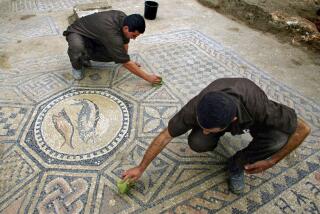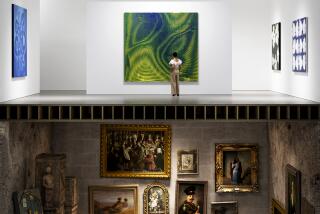Israel Shares a Wealth of Ancient Art
- Share via
Major archeological discoveries from the Land of the Bible go on view Sunday at the Los Angeles County Museum of Art in what supporters of the event are calling the largest and most important exhibition of ancient art from Israel ever to be shown in the United States. “Treasures of the Holy Land: Ancient Art From the Israel Museum” from Israel’s national museum in Jerusalem contains nearly 200 antiquities covering the periods from 10,300 BC to the 7th Century.
The displays have been arranged in the galleries so that the visitor passes from one cultural era to the next in chronological sequence, each a step forward in time.
In the earliest period, there are examples of the Natufian culture, one of the richest in the Near East. Found at Wadi-en-Natuf in the western Judean hills, the artifacts include agricultural tools skillfully carved from bone, harpoons for fishing and mortars for grinding grain.
Continuing their passage through time, visitors will see the human figure represented for the first time in the Neolithic Period from 8500 to 4500 BC. Female figurines made from unbaked clay have been recovered from that time, along with stone masks believed to have been used in religious rituals.
One gallery is devoted to the “Cave of the Treasure,” discovered in 1961 in the Judean Desert in the cliff face above a deep gorge in Nahal Mishomar canyon. To reach the cave, archeologists had to lower themselves to the entrance by a rope ladder. Here, sometime during the second half of the 4th millennium BC, people had managed to reach the cave and created a time capsule of their culture. The objects, wrapped in a mat of reeds, included mace heads and maces, standards, scepters and crowns, various types of textiles, basketwork and leather objects.
In the Bronze Age from the closing centuries of the 4th millennium until 1200 BC, the crafts of the potter and the jeweler reached an unprecedented level of skill.
One can imagine the excitement at Gezar in 1973 as a team from the Hebrew Union College in Jerusalem patiently sifted through rubble during the last hours of the final season of excavation. Two shiny female figurines made of sheet gold and other jewelry were uncovered. The artist who fashioned these delicate dagger-shaped figures left them in a storeroom. When the city was destroyed, the building was buried and sealed by heavy mud debris. There this little treasure would have remained but for a chance discovery. Dated from the 16th Century BC, they can be seen in one of the showcases. And you will view other finds even more spectacular.
Entering a gallery of artifacts dating from the period of Roman occupation of the Holy Land, one encounters a bronze bust of the Roman emperor Hadrian (AD 117-138). Its discoverer was Morton Levenphal, a New York stockbroker who on a trip to Israel in 1975 was searching for coins with a secondhand mine detector in the fields of the kibbutz Tirat-Zvi, where he was staying. Instead of coins, he came upon this 2nd-Century statue of the Emperor Hadrian, lying two feet beneath the surface.
Habbakuk Commentary
A highlight of the exhibition is the Habbakuk Commentary, one of the best preserved of the Dead Sea Scrolls. In 1946 or 1947 a Bedouin shepherd found the first seven of these scrolls. This, the greatest archeological find ever made in the Holy Land, led to the eventual discovery of some 800 manuscripts in Hebrew and Aramaic. Most were in fragments, but some were in fine condition. They were located in 11 caves on the northwestern shore of the Dead Sea.
The exhibit has been organized jointly by the New York Metropolitan Museum of Art and Jerusalem’s Israel Museum. The presentation of the exhibition in Los Angeles is sponsored by the Iris and B. Gerald Cantor Foundation and the Jewish Federation Council of Greater Los Angeles.
County Museum of Art is at 5905 Wilshire Blvd., open Tuesday-Friday, 10 a.m. to 5 p.m., and Saturday and Sunday, 10 a.m.-6 p.m.; closed Mondays. Admission to the Holy Land exhibition is $4 for adults, $2 for children 5 to 12. There is a new Plaza Cafe on the premises and illustrated catalogues of the exhibition are for sale in the museum shop. The exhibit closes July 5.






